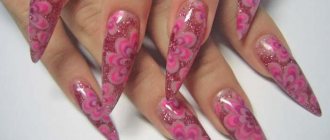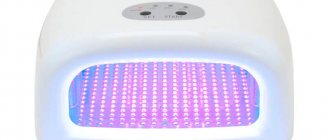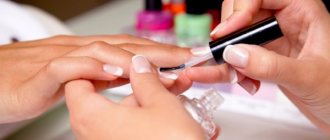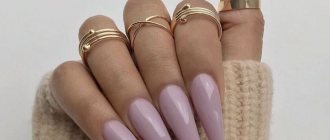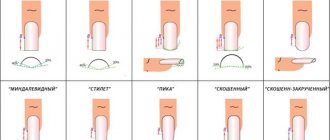Not every woman can boast of beautiful and strong nails, but there are certain procedures designed to improve the condition of the nails and give them an ideal shape.
Nail extensions have recently been in great demand, because with the help of this manipulation you can get rid of ingrown toenails, yellow nail plates, unsightly nail shapes, etc.
This procedure becomes especially relevant with the onset of the warm season, when men look not only at the legs and chest, but also at the woman’s hands. But is it worth giving up vitamins and strengthening varnishes and resorting to nail extensions? What potential harm does this procedure pose?
Nail extension methods
Currently, nails are extended in two ways:
- On forms.
- On tips.
The forms are a plastic or foil plate, which has a window for the nail in the center. To install the form, a nail length of 1-2 mm is required - otherwise it will not be possible to place the form. The extension process takes about 3-4 hours.
Form extensions
Tips are plastic templates that are applied to natural filed nails using special glue, after which the gap between the nails is evened out - all work takes about 3-4 hours.
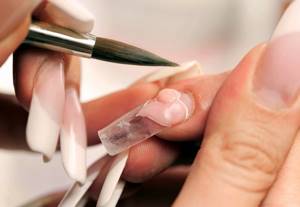
Extension with Tips
Fashionable nail design with gel
Nowadays, trends are increasingly coming down to the fact that many advanced ladies no longer make designs on all their nails, voluminous flowers, or glue large rhinestones.
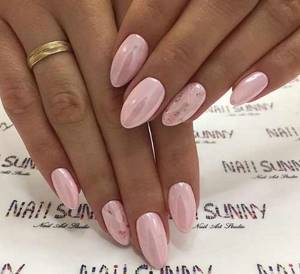
Hits 2022:
- manicure with negative space, minimalistic and graphic design;

- we decorate one or maximum two fingers in an original way;
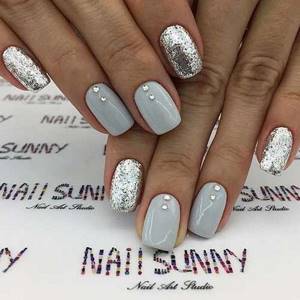
- more often we ask you to do a lunar, one-color, two-color or maximum of three colors manicure in different color variations;
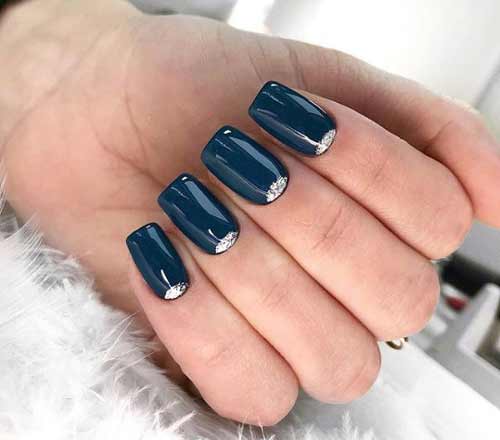
- classic French, colored and with geometry;
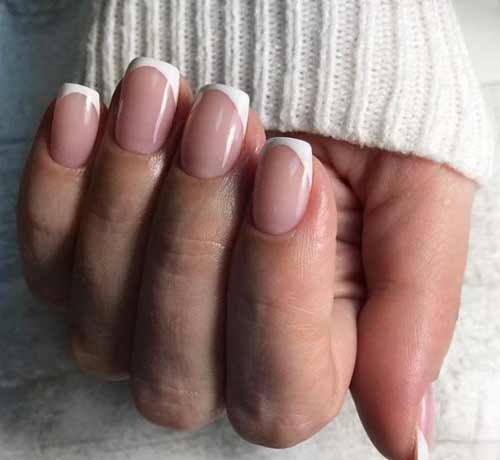
- matte and ruffian manicure.

Regarding the length of nails. In 2022, long nails are rapidly returning to fashion. Influential celebrities Nicki Minaj, Kelly Osbourne, Adele, Beyoncé and Rihanna became trendsetters. They prefer a spectacular manicure. As we see, nails are decorated with sparkles, beads, and rhinestones.
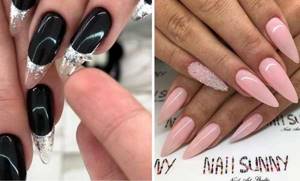
And the choice is yours! But don’t forget about common sense, try to choose with your specialist the length and design of your nails so that you feel comfortable.
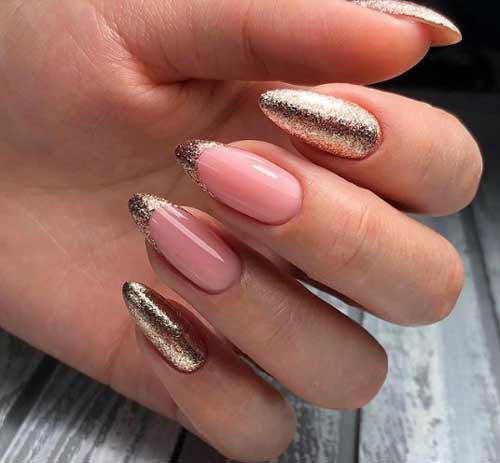
- We recommend: the most fashionable pastel nail polish palette, spring-summer 2018.
- Related: Wipe off immediately, manicures that are no longer in fashion.
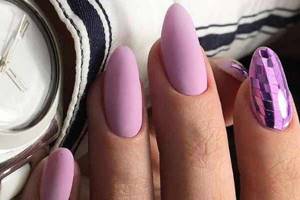
Gel or acrylic?
In a beauty salon, manicurists are able to turn a client’s unkempt and short nails into real beauty - after painstaking work, the nails acquire a completely presentable appearance.
For nail extensions, you can use gel or acrylic, however, all methods have both advantages and disadvantages:
- The gel is a weak allergenic material that does not have a negative effect on the nail itself. However, if damaged, the nail cannot be restored - if it breaks, it will require complete removal, after which the extension will have to be done again.
- Acrylic is able to harden on its own, without requiring any equipment. In addition, acrylic nails are much easier to remove.
In any case, if you plan to do nail extensions using any of the above methods, you should prepare in advance for a fairly long-term procedure that will take at least 3 hours.
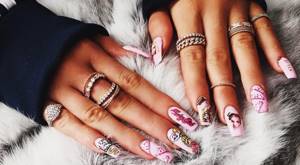
Harm
When applying extensions, every girl runs the risk of ruining her natural nails. Therefore, questions about whether nail extensions are harmful should be considered at the stage of preparation for the procedure. A negative impact can be caused by the fault of the master, from the process itself, as well as from the material used or the characteristics of its application.
Damage due to the fault of the master
Often, all sorts of risks are complicated by a lack of experience or dishonesty of the master. The final beauty of the plates and the health of the nails in the future depend on it. If you choose the wrong nail salon, the damage to your nails grown there can manifest itself in the following:
- Excessive cutting of the natural plate. If the artist uses a file that is too hard or takes too long to file the nail instead of simplifying the task by sanding, then the living nail may be shorter than necessary. This affects both the quality of the final work and the health of the nail.

- Incorrect modeling of nail geometry. When a master makes mistakes by making incorrect calculations, the risk of cracks or plate breakage seriously increases. Moreover, scrapping threatens not only the artificial plate, but also the natural one.
- Use of low-quality materials. Some craftsmen use cheap materials of low quality. This affects the appearance of the plates and their durability, and can also seriously harm your fingers.
- Ignorance of contraindications. Some masters may not even pay attention to obvious problems that prohibit extensions. For example, if the plates are too thin and weak, they may still perform the procedure. As a result, a person will feel pain, get damaged nails and may experience the appearance of wounds.
- Injury caused when removing insoluble materials. If a technician works with a sanding file for too long, he runs the risk of touching the real nail. In such situations, the main damage will be caused to appearance.
It is important to take the issue of choosing a master for such work seriously. It is advisable to give preference to proven specialized salons, where clients are served by experienced manicurists.

Main harm
Not everyone experiences harm from nail extensions. But if you repeat this procedure regularly, the risk of encountering it will increase. Even with the involvement of an experienced master, a girl may suffer from the following problems:
- Injuries to the nail plate with regular repetition of the procedure. After filing the extended plate, it will take 4 months to restore the nail. If you neglect this rule, injuries will appear in the next six months. Cracks, yellowing and delamination are most likely to occur.
- Negative influence of materials. Even when using good materials, there is a risk of encountering a fake that contains harmful components. The liquids evaporate and poison the air, from which the master himself also suffers. They also cause injuries to the nail plates.
- Nail deformation due to lack of oxygen. It is believed that nails do not need air, because... they do not have a breathing apparatus. However, the production of keratin to build nails requires some oxygen. If it is not there, then the extended nail will be deformed and become curved, which will ruin the beauty of the manicure.
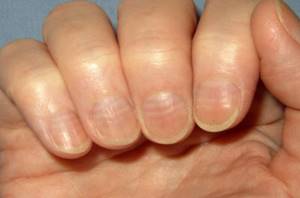
- Stopping the production of the protective layer. When applying various artificial materials for a long time, the formation of natural protection is suspended, and its remnants are removed. For this reason, the real nail becomes extremely vulnerable to the negative influence of the external environment and may turn yellow, thin, or peel.
- Development of bacteria. Microorganisms develop under a layer of artificial materials. This is especially susceptible to those people who often repeat the procedure of extensions or applying different gels to their nails. Bacteria remain in the formed layers, where their effect on the skin or plates is not even noticeable.
It is difficult to say for sure whether extended nails are harmful. Much depends on random factors and the master. But there is a difference in the materials used.
Nail extensions - advantages
Due to the large number of positive effects, many women spend their time and money on this procedure. After all the extension work has been completed, you will notice the following:
- Nails acquire special beauty and style, their length increases;
- All nail defects become invisible;
- You can display any design or pattern on your nail;
- Durable varnish coating that does not require special care for a long time;
- Minimum discomfort during the procedure and quick adaptation to the nails;
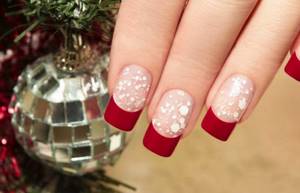
Basic information about acrylic extensions
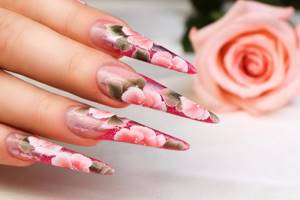
Stages of nail extension with acrylic:
- Nail preparation: polishing the nail plate, removing cuticles, degreasing the surface.
- A special form is put on the nail or a tip is attached to simulate the shape and length of the nail.
- Using monomer and acrylic powder, a ball is formed, which is evenly distributed over the nail plate, and the appearance of the nail is simulated.
- After the base has dried, the master cuts out the final shape of the nail, removes irregularities, and creates a design.
- A top coat is applied which will provide shine and shine to the nails.
Nail artists appreciate acrylic extensions because after applying the material, the nail becomes an ideal canvas for realizing all kinds of ideas and designs.
Nail extensions - disadvantages
In addition to all the advantages of this procedure, there are a number of disadvantages:
- The procedure requires a large amount of time and a fairly large amount of money;
- The owner of artificial gel nails must visit a beauty salon every 2 weeks for periodic correction - this also takes up a significant part of her free time;
- Gel nails are not removable; to remove them, they require complete filing, which only a nail technician can do.
- The natural nail, located under the gel or acrylic plate, decreases in thickness, so after removing the artificial nail, it requires some care.
Should I get my nails done at 13?
Is it possible to do extensions for girls who are still in their teens? Experts in the field of medicine, as well as in the field of providing nail services, often note in their reviews that such a procedure is contraindicated at this age.
Should I get my nails done at 14 or at an earlier age? When answering this question, doctors often pay attention to the fact that during this period of life, a person’s fingers are not yet sufficiently formed, which can lead to subsequent deformation of the nail plate.

Contraindications to the procedure
Contrary to popular belief that anyone can use this procedure, nail extensions have a number of contraindications:
- It is prohibited to carry out extensions if the nail has mechanical damage or is affected by fungus.
- If there is an injury on the cuticle that was received as a result of a trimmed manicure, then extensions are not recommended - if gel or acrylic gets on the wound, inflammation may begin.
- People suffering from diseases of the cardiovascular system can forget about nail extensions.
- If there is increased sweating of the hands, this may also serve as a ban on the procedure of nail extensions.
- If a person is taking antibiotics or hormonal medications, then it is worth holding off on going to a manicurist.
- If you are allergic to some substances used in the extension process, you should avoid such procedures in the future.
Pros of gel extensions
The main advantages of gel nail extensions, regardless of its type:
- Rapidity. An experienced master will not spend more than an hour and a half on the procedure. The time can only be increased depending on the complexity of the future design.
- Strength. The gel material is flexible and lasts longer on the nails than regular varnish or acrylic.
- Quick correction. You can replace an accidentally broken nail extension in just half an hour.
- Strengthening the plates. The gel coating “works” to thicken your own nail, making it stronger. At the same time, it levels the plate.
- No harm. Gel nails can be worn for a long time without interruption. They are completely safe and do not worsen the condition of their own plate.
- Saving. Extensions are much cheaper than acrylic ones.
- No odors. Gel, unlike acrylic, has absolutely no chemical aroma.
- Your own nails breathe under the coating. This significantly reduces the risk of drying them out.
Additional advantages of gel extensions include a large selection of design options, absence of allergies to the material, and the ability to quickly remove. Even if the procedure was carried out using tips, there is no damage left after peeling them off.
Is it better to choose gel nails or acrylic nails?
Advantages of acrylic nails: – strength; – fast polymerization without a lamp; – possibility of complex designs; – modeling.
Pros of gel nails: – strength; – possibility of complex designs; - without smell; – fast polymerization.
Disadvantages of acrylic nails: – smell (not everyone likes it, it seems heavy. But it is absolutely non-toxic. Tested by masters).
Disadvantages of gel nails: – when polymerizing in a lamp, it sometimes bakes (this only lasts 1-2 seconds. And only for clients with sagging nails).
In some cases, clients have individual rejection of the material; this cannot always be determined immediately. Therefore, be sure to discuss the issue of acrylic or gel with the master!
Forms of extended nails: names and photos
The names of the shape of nails during extensions, which are understandable and familiar to masters, often confuse their clients. Moreover, not all young ladies are well acquainted with their names, and this sometimes leads to the fact that instead of the desired option, the client gets a completely different result, and all because she could not correctly name the desired result. Especially to help all women, as well as beginners and those young ladies who practice nail extensions at home, an educational program from “Ideal Manicure” about what types of nails there are when doing extensions, their names and photo examples.
Traditional types of nail shapes for extensions
Let's start our review with the most popular and familiar forms for extended nails. They are usually used to model natural ends, which is why they belong to the so-called category of “traditional” shapes. They are clear, technically simple, and have a natural appearance.
Oval shape.
Characteristic features of the oval shape are parallel lateral lines, equal in width along the entire length of the free edge of the nail and rounded tips.
The most traditional and simplest form in execution technique. It suits nails with any shape of the nail bed - oval, trapezoidal, straight, etc. Oval, in addition, helps to visually lengthen a short nail bed and make excessively wide plates more miniature. Looks best on long and medium length nails.
Photo from the site: vashi-nogti.ru
Photo from the site: obovsemki.com
Photo from the site: kosmetista.ru
Square.
The characteristic features of a square are parallel side lines of the same width along the entire length of the nail and a straight tip with sharp corners at the edges. The ideal solution for French manicure.
The most popular form, both for nail extensions and for the formation of a natural tip. However, this form is more stable in the case of extended nails, because natural plates often break off in the corners. This shape is more suitable for those with a long nail bed. But in the case of extended nails, the problem is easily solved by visually lengthening the nail bed. But those with wide nail plates would be better off with this shape, as the nails will look overly massive. Looks best on medium length nails.
Photo from the site: nogti-nvr.ru
Photo from the site: studio-chereshnya.ru
Photo from the site: sergeybryukhno.ru
Soft square.
Characteristic features of the shape are parallel side lines of the same width along the entire length of the nail and a straight tip with rounded corners. This form can be done with equal success on natural plates and artificial nails.
A soft square, like an oval, suits absolutely everyone. Looks best in a short version and on medium-length nails.
Photo from the site: moda-mir.ru
Photo from the site: cdt-tristar.ru
Photo from the site: mirror-venus.ru
Almond shaped nails.
Characteristic features are a cone-shaped shape, the side lines of the nail from the line of the beginning of the free edge gradually tend to the center and are rounded at the tip of the nail.
Despite the naturalness and simplicity of the form, it is a rather complex and fragile structure. It will look best on extended nails, because it requires good length and the correct cone-shaped outline of the nail arch. Suitable only for ladies with long nail beds, narrow plates and thin “musical” fingers.
Photo from the site: womanadvice.ru
Photo from the site: ss.kak-nay4utc9.ru
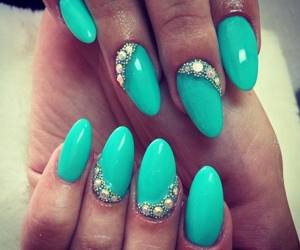
Photo from the site: foto-nogti.ru
"Pointe shoes."
Characteristic features are a trapezoidal shape, the side lines of the nail gradually tend to the center. The tip of the nail has a straight line with sharp corners. This is a kind of mix of “square” and almond-shaped. Outwardly, it resembles a ballerina's pointe shoes, which is why this form is sometimes called "ballerina". Another name is “coffin,” again because of its characteristic shape.
The most popular nail shape in the 2022 season. Suitable for almost any shape of the nail bed. It is quite difficult to perform on natural nails; it looks best and is more “vital” when done artificially. Any length is suitable.
Photo from the site: moneyclone.ru
Photo from the site: favim.ru
Photo from the site: salon-lime.ru
Important
Before choosing one or another fashionable nail shape, critically evaluate the shape of your fingers and nail bed. An unsuitable shape can negate the entire effect of extended nails.
Exotic forms of extended nails: names and photos
The good thing about artificial material is that it allows you to create on its base various, sometimes very extravagant, shapes that are simply impossible to create on natural nails. This is because such forms require a certain design, which is impossible when working with a natural plate. In addition, such variations of forms, as a rule, are only dared by very brave girls who are not afraid to shock the public. Let's look at the most popular nail shapes for extensions from this group and photos for them.
"Stilettos".
Characteristic features are very long cone-shaped nails with straight, full-face edges, tending towards the center, and forming an acute angle at the top. They also have a straight outline in profile. Outwardly they resemble daggers, hence their name.
The most recognizable form in the group of exotic variations. Suitable for extravagant young ladies who love to attract attention to themselves. They look quite bold, defiant, but, nevertheless, not vulgar. These nails just need a spectacular design and bright colors. Look great on nails with any shape of nail bed. Suitable length - the longer the better.
Photo from the site: thenailshop.ru

Photo from the site: vidpovidi.net.ua
Photo from the site: salonguru.ru
“Pipe”, tube.
Characteristic features are the same outlines as stilettos, but unlike the first, “pipe” marigolds have a less pronounced angle of inclination of the side edges of the free tip, and the tip itself is almond-shaped. In cross section they resemble a tube, hence their name.
This form looks very elegant, despite its “belonging” to the group of exotic marigolds. Suitable for any nail bed shape. They look preferable in longer lengths.
Photo from the site: boginja.all-gorod.ru
Photo from the site: boginja.all-gorod.ru
Photo from the site: liferules.com.ua
"Edge."
Characteristic features are straight parallel side edges, which sharply narrow in the middle of the length of the free edge, forming an acute angle at the central apex. They are a mix of square and stiletto.
This form is very complex to execute and requires a certain amount of finesse in execution. The design is required, but it should be light - aqua motifs, 2 - 3 colors, so as not to visually overload the already complex form. Suitable for absolutely everyone. The optimal length is only long.
Photo from the site: mara-af.ru
Photo from the site: term-home.com
Photo from the site: otvet.mail.ru
Slanted nails.
Characteristic features are straight parallel side edges, identical along the entire length of the free edge. The tip has a straight beveled edge, forming two angles - acute and obtuse.
Quite an eccentric shape, suitable for very girls. Looks good on any nail bed shape, but requires long, graceful fingers. The appropriate size is medium to long tip.
Photo from the site: nailclub.ru
Photo from the site: lor-rb.ru
Photo from the site: womenworld.com.ua
Blade shape or butterfly wings.
Characteristic features - the free edge has the shape of a triangle in cross-section. Straight edges that may widen slightly closer to the tip, and then sharply tend to the center, forming a fancy cut in the form of a butterfly wing.
The most difficult form to perform. It looks incredibly beautiful and gentle. Not very suitable for everyday life; it is best to create such a form to coincide with some kind of festive event. Suitable for all fingers and nail bed shapes. Looks best on long and medium length nails. Requires bright decor and designer content. Sequins and rhinestones are welcome.
Photo from the site: flyfix.ru
Photo from the site: nanogte.ru
Photo from the site: flyfix.ru
Naturally, the given names of the shape of extended nails are not exhausted by the list given here. We have only given descriptions of the most common forms. There are other options, but they differ little from those given here and, as a rule, represent a symbiosis of two or three forms, or unusual variations in the design of the arch or side faces.
Modern extension methods
There are several technologies for extensions, but gel or acrylic remain popular. Each nail plate lengthening procedure contains its own pros, cons, and nuances.
Acrylic:
- Acrylic dries quickly, so it is not recommended to use it at home.
- You can decide on the color in advance and use the desired shade of the material, suitable for three-dimensional design.
- Stays on the nails for a long time, the material is thin, durable, and difficult to break.
- There is a risk of getting an allergic reaction.
- The removal procedure is simple, you just need to hold the marigolds in a special solution until they soften, then remove the residue with a spatula.
- After removing the acrylic, the plates will be weakened, unaesthetic, and dull in appearance.
- Chemical components emit a strong, persistent odor.
- Defects can be easily corrected without changing the coating.
Gel:
- A UV lamp is required for drying; a burning sensation often occurs during drying.
- Hypoallergenic, considered safe for the skin and stratum corneum.
- There is no pungent odor, so there are no foreign impurities.
- The model is easier to form, since the gel is easier to file off.
- Protects the plate and has less harmful effects.
- It becomes less resistant with a sudden change in temperature, cracks appear that cannot be repaired, and you will have to remove the gel from the entire surface.
- Difficulties will arise during removal; the gel must be cut off; in the process, the top layer of the plate is often damaged.
- There have been cases of allergies to dust when cutting off the gel.




